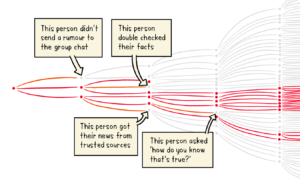
Getting It Right
What should we believe, and what shouldn’t we, when it comes to information about COVID-19?
The World Health Organization (WHO) provides good advice on telling the difference between reliable information and misinformation. It recommends learning about “infodemiology”, the study of the vast amounts of information disseminated on the health crisis, not only from scientific sources but also from governments and health agencies worldwide, news articles and opinion pieces, and messages from vloggers, bloggers, podcasters and social media influencers. How should that information be dealt with? The WHO’s curve demonstrates how the infodemic, or the “overabundance of information” on the COVID-19 pandemic can be managed.
The WHO recommends the following seven tips, verbatim from its website, to recognize false or inaccurate information or incorrect information intended to mislead:
- Assess the source: Who shared the information with you and where did they get it from? Even if it is friends or family, you still need to vet their source.
- Go beyond headlines: Headlines may be intentionally sensational or provocative.
- Identify the author: Search the author’s name online to see if they are real or credible.
- Check the date: Is it up to date and relevant to current events? Has a headline, image or statistic been used out of context?
- Examine the supporting evidence: Credible stories back up their claims with facts.
- Check your biases: Think about whether your own biases could affect your judgment on what is or is not trustworthy.
- Turn to fact-checkers: Consult trusted fact-checking organizations, such as the International Fact-Checking Network and global news outlets focused on debunking misinformation.
Here are some FACTS about coronavirus disease:
- Vitamin and mineral supplements cannot cure COVID-19
- Studies show hydroxychloroquine does not have clinical benefits in treating COVID-19
- People should NOT wear masks while exercising
- Water or swimming does not transmit the COVID-19 virus
- The likelihood of shoes spreading COVID-19 is very low
- The coronavirus disease (COVID-19) is caused by a virus, NOT by bacteria
- The prolonged use of medical masks [also known as surgical masks] when properly worn, DOES NOT cause CO2 intoxication nor oxygen deficiency
- Most people who get COVID-19 recover from it
- Drinking alcohol does not protect you against COVID-19 and can be dangerous
- Thermal scanners CANNOT detect COVID-19
- Adding pepper to your soup or other meals DOES NOT prevent or cure COVID-19
- COVID-19 is NOT transmitted through houseflies
- Spraying and introducing bleach or another disinfectant into your body WILL NOT protect you against COVID-19 and can be dangerous
- Drinking methanol, ethanol or bleach DOES NOT prevent or cure COVID-19 and can be extremely dangerous
- 5G mobile networks DO NOT spread COVID-19
- Exposing yourself to the sun or temperatures higher than 25°C DOES NOT protect you from COVID-19
- Catching COVID-19 DOES NOT mean you will have it for life
- Being able to hold your breath for 10 seconds or more without coughing or feeling discomfort DOES NOT mean you are free from COVID-19
- The COVID-19 virus can spread in hot and humid climates
- Cold weather and snow CANNOT kill the COVID-19 virus
- Taking a hot bath does not prevent COVID-19
- The COVID-19 virus CANNOT be spread through mosquito bites
- Hand dryers are NOT effective in killing the COVID-19 virus
- Ultra-violet (UV) lamps should NOT be used to disinfect hands or other areas of your skin
- Vaccines against pneumonia DO NOT protect against the COVID-19 virus
- Rinsing your nose with saline does NOT prevent COVID-19
- Eating garlic does NOT prevent COVID-19
- People of all ages can be infected by the COVID-19 virus
- Antibiotics CANNOT prevent or treat COVID-19
More on all these facts is available from the WHO at Mythbusters.
Every person can contribute to alleviating the flood of information, whether accurate or not, and can help flatten the infodemic curve. So consider honing your skills to recognize low-quality information, and question the information you come by. Propagate the truth, such as the above facts, as opposed to interpretation.


